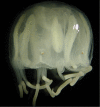The evolution of eyes: major steps. The Keeler lecture 2017: centenary of Keeler Ltd
- PMID: 29052606
- PMCID: PMC5811732
- DOI: 10.1038/eye.2017.226
The evolution of eyes: major steps. The Keeler lecture 2017: centenary of Keeler Ltd
Abstract
Ocular evolution is an immense topic, and I do not expect to cover all the details of this process in this manuscript. I will present some concepts about some of the major steps in the evolutionary process to stimulate your thinking about this interesting and complex topic. In the prebiotic soup, vision was not inevitable. Eyes were not preordained. Nor were their shapes, sizes, or current physiology. Sight is an evolutionary gift but it was not ineluctable. The existence of eyes is so basic to our profession that we often do not consider how and why vision appeared or evolved on earth at all. Although vision is a principal sensory modality for at least three major phyla and is present in three or four more phyla, there are other sensory mechanisms that could have been and were occasionally selected instead. Some animals rely on other sensory mechanisms such as audition, echolocation, or olfaction that are much more effective in their particular niche than would be vision. We may not believe those sensory mechanisms to be as robust as vision, but the creatures using those skills would argue otherwise. Why does vision exist at all? And why is it so dominant at least in the number of species that rely upon it for their principal sensory mechanism? How did vision begin? What were the important steps in the evolution of eyes? How did eyes differentiate along their various paths, and why?
Conflict of interest statement
The author declares no conflict of interest.
Figures












References
-
- Reith M, Munholland J. Complete nucleotide sequence of the Porphyra purpurea chloroplast genome. Plant Mol Biol Rep 1995; 13: 333–335.
-
- Grote M, Engelhard M, Hegemann P. Of ion pumps, sensors and channels-perspectives on microbial rhodopsins between science and history. Biochim Biophys Acta 2014; 1837: 533–545. - PubMed
-
- Porter ML. Beyond the eye: molecular evolution of extraocular photoreception. Integr Comp Biol 2016; 56: 842–852. - PubMed
Publication types
MeSH terms
Substances
LinkOut - more resources
Full Text Sources
Other Literature Sources

